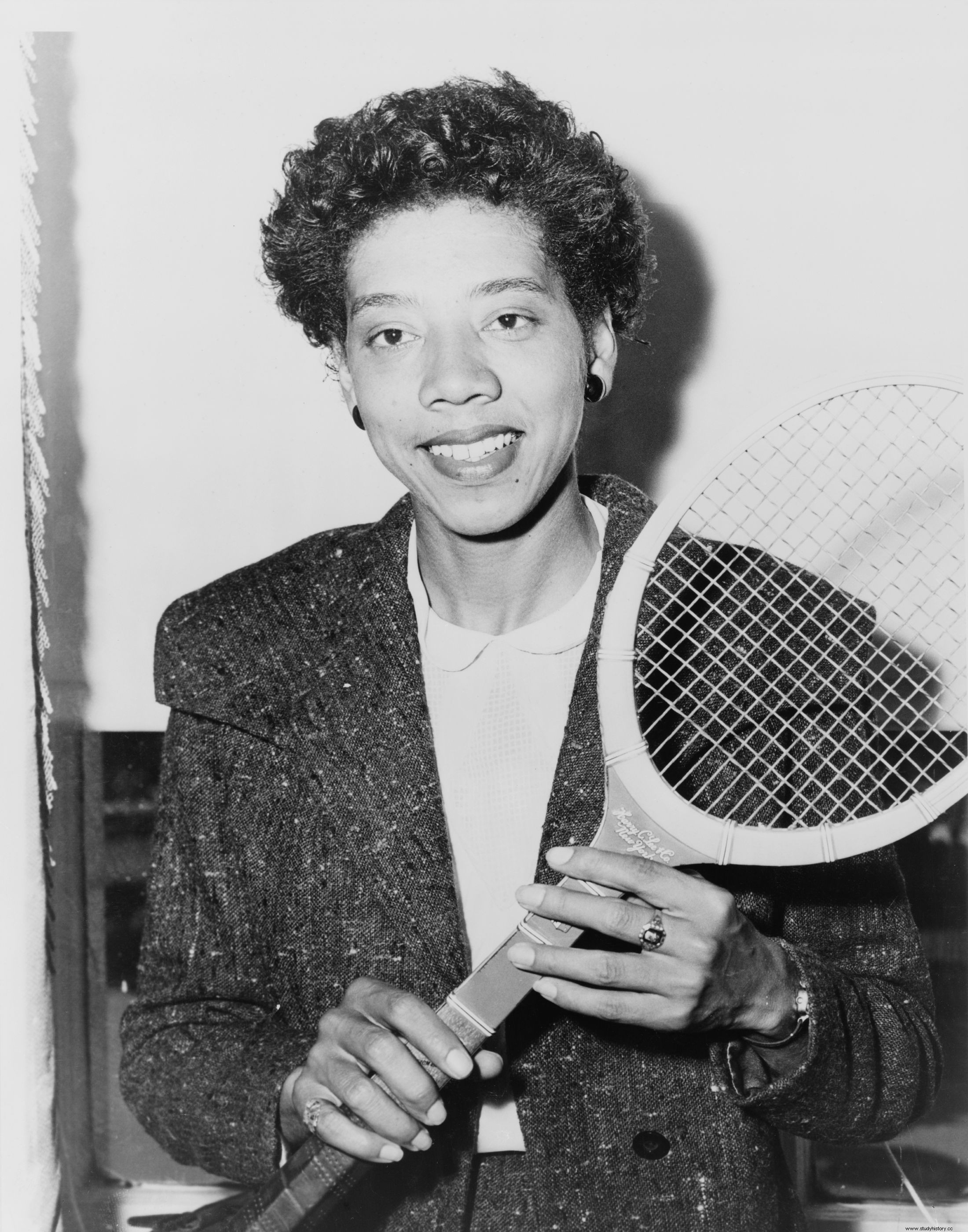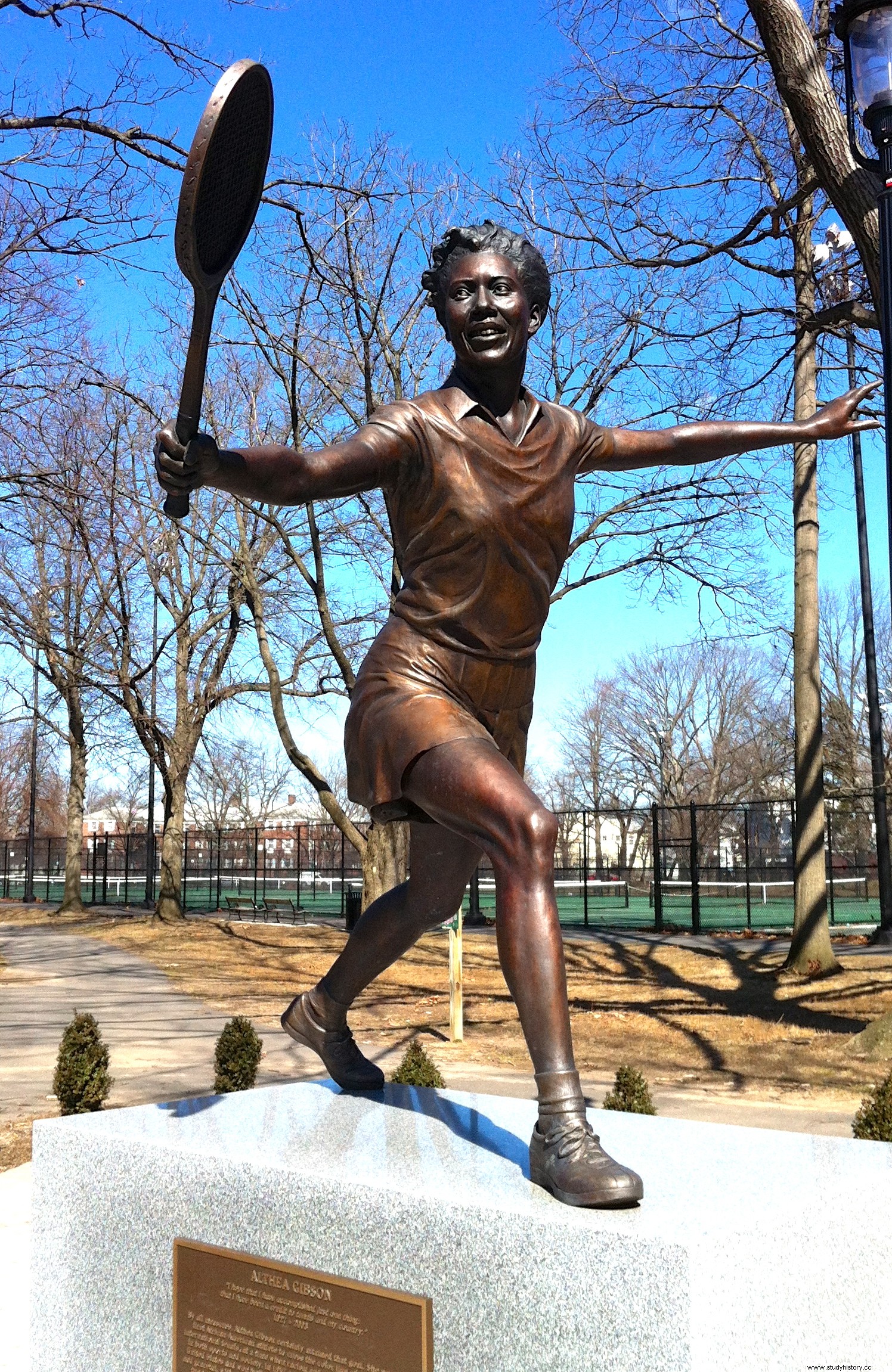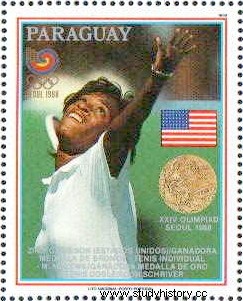American golf player and tennis champion, Althea Gibson (1927 – 2003) was the first black player to win a Grand Slam tournament, twelve years before Arthur Ashe. To reach the top in the midst of racial segregation, she must confront racism, sexism and prejudice.
A sporty childhood

Daughter of Annie Bell and Daniel Gibson, sharecroppers, Althea Gibson was born on August 25, 1927 in Silver, South Carolina (United States). Heavily hit by the economic crisis of the 1930s, the Gibson family left their land to settle in Harlem, where Althea's three siblings were born.
The street where the Gibsons live is barricaded during the day to allow the children to practice sports. Paddle tennis, a racquet sport derived from tennis, was then very popular in New York and Althea quickly became famous. At the age of twelve, she was crowned champion of the women's paddle tennis tournament in New York.
Young prodigy
Entering a tennis club with the help of a group of neighbors, Althea Gibson wins her first tournament, the New York State Championshop of the American Tennis Association (ATA), an association intended to promote and develop tennis with African-American players. She won the ATA national tournament in 1944 and 1945; from 1947, Althea would win the title ten times in a row. At the time, she realizes that she has gold in her racket:
“I knew that I was an unusual, talented girl, through the grace of God, I didn’t need to prove that to myself. I only wanted to prove it to my opponents. » ( That Gibson Girl. » Time , August 26, 1957, p. 46.)
(I knew I had an unusual talent, thank God I didn't need to prove it to myself. I just wanted to prove it to my opponents).
The US Open
Althea Gibson's talent and success caught the attention of Robert Walter Johnson, physicist and founder of the American Junior Tennis Association, who took her under his wing. She thus has access to more advanced training and training, and can participate in more important competitions. From 1949, she was able to participate in tournaments of the United States Tennis Federation (USTA). The same year, she entered the Florida Agricultural and Mechanical University, a black university in Florida, with an athletic scholarship. It is one of eleven member universities of the State University System of Florida.
Despite her talent, Althea could not participate in the most important tournament:the US National Championships, which would become the US Open, one of the four major tennis tournaments in the world. The regulations exclude racial discrimination, but to access it you must accumulate enough victories in tournaments frequently organized in clubs reserved for whites. Gamer Alice Marble comes to her defense in an open letter:
“If Althea Gibson represents a challenge to the present crop of women players, it’s only fair that they should meet that challenge on the courts. »
(If Althea Gibson represents a challenge for this generation of players, it is only fair that they can face this challenge on the courts)
Following this letter and lobbying by the ATA, Althea eventually received an invitation to the 1950 US National Championships; she is the first black player to participate. Despite his defeat in the second round, his participation in the tournament in the midst of racial segregation is already making history. A story that she shaped again the following year, being the first black player at the Wimbledon tournament.
Crown at Roland-Garros

In 1953, Althea Gibson graduated from college and taught physical education at Lincoln University in Missouri. She stayed there for two years:in 1955, she was part of a delegation sent to Asia to play exhibition matches. She received a very favorable reception there, and extended this six-week tour with a series of tournaments in Europe and Asia; she faces the best players in the world and wins sixteen of the eighteen competitions in which she participates.
In 1956, Althea won the Roland-Garros tournament, one of the four main tennis competitions in the world. Twelve years before Arthur Ashe who is often presented as such, she is the first black player to win a Grand Slam tournament. And has the luxury of also winning the doubles title, with British player Angela Buxton.
“The Year of Althea Gibson”
1957 was such a successful year for Althea that she herself dubbed it “Althea Gibson’s year” (“the year of Althea Gibson”). First black player to win the Wimbledon tournament, she is also the first champion to receive her trophy from Queen Elizabeth II. An extraordinary achievement, at a time when black people are suffering from racial segregation in the United States.
“Shaking hands with the queen of England was a long way from being forced to sit in the colored section of the bus. »
(It was a long way from shaking hands with the Queen of England to being forced to sit in the “colored” section of the bus)
That same year, Althea reached the final at the Australian Open and, most importantly, won the US National, a major victory in her own country. She also won doubles in Australia and Wimbledon, and won the US National in mixed doubles. The Mayor of New York presents him with the Bronze Medallion, the highest honor given to civilians by the City of New York.
During her career, Althea Gibson won five Grand Slam tournaments in singles, five in doubles and one in mixed doubles. She was world number one in 1957 and 1958, and was named Sportswoman of the Year (Associated Press) both years. She is the first black woman to grace the cover of Time .
End of amateur career
In 1958, however, Althea Gibson put an end to her amateur career; at the time, the prestigious tournaments of the amateur circuit were not rewarded with bonuses and the champion was experiencing financial difficulties, as she explains with humor:
“Being the Queen of Tennis is all well and good, but you can’t eat a crown. Nor can you send the Internal Revenue Service a throne clipped to their tax forms. The landlord and grocer and tax collector are funny that way:they like cold cash … I reign over an empty bank account, and I’m not going to fill it by playing amateur tennis. ( Gibson A., Curtis R., So Much to Live For . New York, Putnam (1968))
(Being the queen of tennis is great, but you can't eat a crown. Neither can you send the Internal Revenue Service a throne stapled to the tax return. The owner, the grocer and the tutor have a funny thing in common:they like real money… I rule over an empty bank account, and I'm not going to fill it by playing amateur tennis)
Althea embarks on a career as a singer and saxophonist. She records an album, appears in a television program and obtains a role in the film Les Cavaliers by John Ford. She publishes an autobiography and works in sports commentary.
Althea does not give up tennis, however, participating in promotional tours and rare tournaments on the professional circuit, much less prestigious and popular than amateur tennis. But his professional career again comes up against discrimination:
“When I looked around me, I saw that white tennis players, some of whom I had thrashed on the court, were picking up offers and invitations. Suddenly it dawned on me that my triumphs had not destroyed the racial barriers once and for all, as I had—perhaps naively—hoped. »
(Looking around me, I saw that the white tennis players, some of whom I had beaten on the courts, were receiving the offers and the invitations. Suddenly, I realized that my triumphs had not definitively brought down the racial boundaries, as I had – perhaps naively – hoped.)
In 1964, Althea embarked on a career as a golfer, where she also had to face violent racial discrimination, in hotels, in clubs, in tournaments. She obtained a rank of 27th player in the world, but still struggled to make ends meet and ended her golf career in 1978.
One of the best players

After her sports careers, Althea Gibson embarked on projects in favor of the practice of tennis in disadvantaged neighborhoods. In turn, she takes under her wing young players, like Zina Garrison. Althea Gibson died in September 2003, at the age of 76, after having marked the history of tennis as a pioneer and great champion.
“She is one of the greatest players who ever lived” Robert Ryland, former coach of Venus and Serena Williams. (She is one of the best players who ever lived)
“Her road to success was a challenging one, but I never saw her back down. » Billie Jean King (Her road to success was full of obstacles, but I never saw her back down)
“I am honored to have followed in such great footsteps. Her accomplishments set the stage for my success, and through players like myself and Serena and many others to come, her legacy will live on. » Venus Williams (I am honored to walk in such exceptional steps. Her accomplishments paved the way for my success, and her legacy will live on through players like Serena and me, and many more to come)
Useful links
Althea Gibson Wikipedia page
Althea Gibson Wikipedia page in English (more complete)
